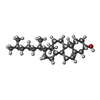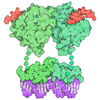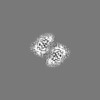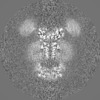+ Open data
Open data
- Basic information
Basic information
| Entry |  | |||||||||
|---|---|---|---|---|---|---|---|---|---|---|
| Title | ABCG2 in complex with AZ99 and 5D3 Fab | |||||||||
 Map data Map data | ||||||||||
 Sample Sample |
| |||||||||
 Keywords Keywords | Multidrug transporter / TRANSPORT PROTEIN | |||||||||
| Function / homology |  Function and homology information Function and homology informationbiotin transmembrane transporter activity / biotin transport / riboflavin transport / riboflavin transmembrane transporter activity / sphingolipid transporter activity / renal urate salt excretion / Abacavir transmembrane transport / urate metabolic process / sphingolipid biosynthetic process / urate transmembrane transporter activity ...biotin transmembrane transporter activity / biotin transport / riboflavin transport / riboflavin transmembrane transporter activity / sphingolipid transporter activity / renal urate salt excretion / Abacavir transmembrane transport / urate metabolic process / sphingolipid biosynthetic process / urate transmembrane transporter activity / Sphingolipid de novo biosynthesis / external side of apical plasma membrane / xenobiotic transport across blood-brain barrier / organic anion transport / transepithelial transport / : / Ciprofloxacin ADME / export across plasma membrane / Paracetamol ADME / NFE2L2 regulating MDR associated enzymes / Differentiation of Keratinocytes in Interfollicular Epidermis in Mammalian Skin / ABC-type xenobiotic transporter / Heme biosynthesis / cellular detoxification / ABC-type xenobiotic transporter activity / Heme degradation / efflux transmembrane transporter activity / ATPase-coupled transmembrane transporter activity / xenobiotic transmembrane transporter activity / transport across blood-brain barrier / brush border membrane / Iron uptake and transport / transmembrane transport / mitochondrial membrane / apical plasma membrane / membrane raft / protein homodimerization activity / ATP hydrolysis activity / nucleoplasm / ATP binding / identical protein binding / plasma membrane Similarity search - Function | |||||||||
| Biological species |  Homo sapiens (human) / Homo sapiens (human) /  | |||||||||
| Method | single particle reconstruction / cryo EM / Resolution: 3.0 Å | |||||||||
 Authors Authors | Yu Q / Kowal J / Tajkhorshid E / Altmann KH / Locher KP | |||||||||
| Funding support |  Switzerland, 1 items Switzerland, 1 items
| |||||||||
 Citation Citation |  Journal: ACS Chem Biol / Year: 2024 Journal: ACS Chem Biol / Year: 2024Title: Modulation of ABCG2 Transporter Activity by Ko143 Derivatives. Authors: Qin Yu / Sepehr Dehghani-Ghahnaviyeh / Ali Rasouli / Anna Sadurni / Julia Kowal / Rose Bang-Soerensen / Po-Chao Wen / Melanie Tinzl-Zechner / Rossitza N Irobalieva / Dongchun Ni / Henning ...Authors: Qin Yu / Sepehr Dehghani-Ghahnaviyeh / Ali Rasouli / Anna Sadurni / Julia Kowal / Rose Bang-Soerensen / Po-Chao Wen / Melanie Tinzl-Zechner / Rossitza N Irobalieva / Dongchun Ni / Henning Stahlberg / Karl-Heinz Altmann / Emad Tajkhorshid / Kaspar P Locher /   Abstract: ABCG2 is a multidrug transporter that protects tissues from xenobiotics, affects drug pharmacokinetics, and contributes to multidrug resistance of cancer cells. Here, we present tetracyclic ...ABCG2 is a multidrug transporter that protects tissues from xenobiotics, affects drug pharmacokinetics, and contributes to multidrug resistance of cancer cells. Here, we present tetracyclic fumitremorgin C analog Ko143 derivatives, evaluate their modulation of purified ABCG2, and report four high-resolution cryo-EM structures and computational analyses to elucidate their interactions with ABCG2. We found that Ko143 derivatives that are based on a ring-opened scaffold no longer inhibit ABCG2-mediated transport activity. In contrast, closed-ring, tetracyclic analogs were highly potent inhibitors. Strikingly, the least potent of these compounds, MZ82, bound deeper into the central ABCG2 cavity than the other inhibitors and it led to partial closure of the transmembrane domains and increased flexibility of the nucleotide-binding domains. Minor structural modifications can thus convert a potent inhibitor into a compound that induces conformational changes in ABCG2 similar to those observed during binding of a substrate. Molecular dynamics simulations and free energy binding calculations further supported the correlation between reduced potency and distinct binding pose of the compounds. We introduce the highly potent inhibitor AZ99 that may exhibit improved stability. | |||||||||
| History |
|
- Structure visualization
Structure visualization
| Supplemental images |
|---|
- Downloads & links
Downloads & links
-EMDB archive
| Map data |  emd_18003.map.gz emd_18003.map.gz | 16.2 MB |  EMDB map data format EMDB map data format | |
|---|---|---|---|---|
| Header (meta data) |  emd-18003-v30.xml emd-18003-v30.xml emd-18003.xml emd-18003.xml | 17.6 KB 17.6 KB | Display Display |  EMDB header EMDB header |
| Images |  emd_18003.png emd_18003.png | 110.8 KB | ||
| Masks |  emd_18003_msk_1.map emd_18003_msk_1.map | 216 MB |  Mask map Mask map | |
| Filedesc metadata |  emd-18003.cif.gz emd-18003.cif.gz | 6.6 KB | ||
| Others |  emd_18003_half_map_1.map.gz emd_18003_half_map_1.map.gz emd_18003_half_map_2.map.gz emd_18003_half_map_2.map.gz | 169 MB 169 MB | ||
| Archive directory |  http://ftp.pdbj.org/pub/emdb/structures/EMD-18003 http://ftp.pdbj.org/pub/emdb/structures/EMD-18003 ftp://ftp.pdbj.org/pub/emdb/structures/EMD-18003 ftp://ftp.pdbj.org/pub/emdb/structures/EMD-18003 | HTTPS FTP |
-Validation report
| Summary document |  emd_18003_validation.pdf.gz emd_18003_validation.pdf.gz | 862.1 KB | Display |  EMDB validaton report EMDB validaton report |
|---|---|---|---|---|
| Full document |  emd_18003_full_validation.pdf.gz emd_18003_full_validation.pdf.gz | 861.7 KB | Display | |
| Data in XML |  emd_18003_validation.xml.gz emd_18003_validation.xml.gz | 15.5 KB | Display | |
| Data in CIF |  emd_18003_validation.cif.gz emd_18003_validation.cif.gz | 18.3 KB | Display | |
| Arichive directory |  https://ftp.pdbj.org/pub/emdb/validation_reports/EMD-18003 https://ftp.pdbj.org/pub/emdb/validation_reports/EMD-18003 ftp://ftp.pdbj.org/pub/emdb/validation_reports/EMD-18003 ftp://ftp.pdbj.org/pub/emdb/validation_reports/EMD-18003 | HTTPS FTP |
-Related structure data
| Related structure data |  8pxoMC  8py4C  8q7bC  8qcmC M: atomic model generated by this map C: citing same article ( |
|---|---|
| Similar structure data | Similarity search - Function & homology  F&H Search F&H Search |
- Links
Links
| EMDB pages |  EMDB (EBI/PDBe) / EMDB (EBI/PDBe) /  EMDataResource EMDataResource |
|---|---|
| Related items in Molecule of the Month |
- Map
Map
| File |  Download / File: emd_18003.map.gz / Format: CCP4 / Size: 216 MB / Type: IMAGE STORED AS FLOATING POINT NUMBER (4 BYTES) Download / File: emd_18003.map.gz / Format: CCP4 / Size: 216 MB / Type: IMAGE STORED AS FLOATING POINT NUMBER (4 BYTES) | ||||||||||||||||||||||||||||||||||||
|---|---|---|---|---|---|---|---|---|---|---|---|---|---|---|---|---|---|---|---|---|---|---|---|---|---|---|---|---|---|---|---|---|---|---|---|---|---|
| Projections & slices | Image control
Images are generated by Spider. | ||||||||||||||||||||||||||||||||||||
| Voxel size | X=Y=Z: 0.66 Å | ||||||||||||||||||||||||||||||||||||
| Density |
| ||||||||||||||||||||||||||||||||||||
| Symmetry | Space group: 1 | ||||||||||||||||||||||||||||||||||||
| Details | EMDB XML:
|
-Supplemental data
-Mask #1
| File |  emd_18003_msk_1.map emd_18003_msk_1.map | ||||||||||||
|---|---|---|---|---|---|---|---|---|---|---|---|---|---|
| Projections & Slices |
| ||||||||||||
| Density Histograms |
-Half map: #1
| File | emd_18003_half_map_1.map | ||||||||||||
|---|---|---|---|---|---|---|---|---|---|---|---|---|---|
| Projections & Slices |
| ||||||||||||
| Density Histograms |
-Half map: #2
| File | emd_18003_half_map_2.map | ||||||||||||
|---|---|---|---|---|---|---|---|---|---|---|---|---|---|
| Projections & Slices |
| ||||||||||||
| Density Histograms |
- Sample components
Sample components
-Entire : ABCG2 in complex with AZ99 and 5D3 Fab
| Entire | Name: ABCG2 in complex with AZ99 and 5D3 Fab |
|---|---|
| Components |
|
-Supramolecule #1: ABCG2 in complex with AZ99 and 5D3 Fab
| Supramolecule | Name: ABCG2 in complex with AZ99 and 5D3 Fab / type: complex / ID: 1 / Parent: 0 / Macromolecule list: #1-#3 |
|---|---|
| Source (natural) | Organism:  Homo sapiens (human) Homo sapiens (human) |
| Molecular weight | Theoretical: 244 KDa |
-Macromolecule #1: 5D3(Fab) heavy chain variable domain
| Macromolecule | Name: 5D3(Fab) heavy chain variable domain|Mus musculus / type: protein_or_peptide / ID: 1 / Number of copies: 2 / Enantiomer: LEVO |
|---|---|
| Source (natural) | Organism:  |
| Molecular weight | Theoretical: 23.843633 KDa |
| Sequence | String: QVQLQESGPG LVKPSQSLSL TCTVTGFSIT SDYAWNWIRQ FPGKKLEWMG YINFDGGTTY NPSLRGRISI TRDTSKNQFF LQLRSVTPE DTATYYCATF YGAKGTLDYW GQGTSVTVSS AKTTPPSVYP LAPVCGDTSG SSVTLGCLVK GYFPEPVTLT W NSGSLSSG ...String: QVQLQESGPG LVKPSQSLSL TCTVTGFSIT SDYAWNWIRQ FPGKKLEWMG YINFDGGTTY NPSLRGRISI TRDTSKNQFF LQLRSVTPE DTATYYCATF YGAKGTLDYW GQGTSVTVSS AKTTPPSVYP LAPVCGDTSG SSVTLGCLVK GYFPEPVTLT W NSGSLSSG VHTFPAVLQS DLYTLSSSVT VTSSTWPSQS ITCNVAHPAS STKVDKKIEP RGP |
-Macromolecule #2: 5D3(Fab) light chain variable domain
| Macromolecule | Name: 5D3(Fab) light chain variable domain / type: protein_or_peptide / ID: 2 / Number of copies: 2 / Enantiomer: LEVO |
|---|---|
| Source (natural) | Organism:  |
| Molecular weight | Theoretical: 23.594016 KDa |
| Sequence | String: DIVLTQSPSS FSVSLGDRVT ISCKASGYIL NRLAWYQQKP GNAPRLLISG ATSLETGFPS RFSGTGSGKD YTLSISSLQT EDVGTYYCQ QYWSTPWTFG GGTKLEIRRA DAAPTVSIFP PSSEQLTSGG ASVVCFLNNF YPKDINVKWK IDGSERQNGV L NSWTDQDS ...String: DIVLTQSPSS FSVSLGDRVT ISCKASGYIL NRLAWYQQKP GNAPRLLISG ATSLETGFPS RFSGTGSGKD YTLSISSLQT EDVGTYYCQ QYWSTPWTFG GGTKLEIRRA DAAPTVSIFP PSSEQLTSGG ASVVCFLNNF YPKDINVKWK IDGSERQNGV L NSWTDQDS KDSTYSMSST LTLTKDEYER HNSYTCEATH KTSTSPIVKS FNRNEC |
-Macromolecule #3: Broad substrate specificity ATP-binding cassette transporter ABCG2
| Macromolecule | Name: Broad substrate specificity ATP-binding cassette transporter ABCG2 type: protein_or_peptide / ID: 3 / Number of copies: 2 / Enantiomer: LEVO / EC number: ABC-type xenobiotic transporter |
|---|---|
| Source (natural) | Organism:  Homo sapiens (human) Homo sapiens (human) |
| Molecular weight | Theoretical: 73.526938 KDa |
| Recombinant expression | Organism:  Homo sapiens (human) Homo sapiens (human) |
| Sequence | String: MDYKDDDDKG SSSSNVEVFI PVSQGNTNGF PATASNDLKA FTEGAVLSFH NICYRVKLKS GFLPCRKPVE KEILSNINGI MKPGLNAIL GPTGGGKSSL LDVLAARKDP SGLSGDVLIN GAPRPANFKC NSGYVVQDDV VMGTLTVREN LQFSAALRLA T TMTNHEKN ...String: MDYKDDDDKG SSSSNVEVFI PVSQGNTNGF PATASNDLKA FTEGAVLSFH NICYRVKLKS GFLPCRKPVE KEILSNINGI MKPGLNAIL GPTGGGKSSL LDVLAARKDP SGLSGDVLIN GAPRPANFKC NSGYVVQDDV VMGTLTVREN LQFSAALRLA T TMTNHEKN ERINRVIQEL GLDKVADSKV GTQFIRGVSG GERKRTSIGM ELITDPSILF LDEPTTGLDS STANAVLLLL KR MSKQGRT IIFSIHQPRY SIFKLFDSLT LLASGRLMFH GPAQEALGYF ESAGYHCEAY NNPADFFLDI INGDSTAVAL NRE EDFKAT EIIEPSKQDK PLIEKLAEIY VNSSFYKETK AELHQLSGGE KKKKITVFKE ISYTTSFCHQ LRWVSKRSFK NLLG NPQAS IAQIIVTVVL GLVIGAIYFG LKNDSTGIQN RAGVLFFLTT NQCFSSVSAV ELFVVEKKLF IHEYISGYYR VSSYF LGKL LSDLLPMRML PSIIFTCIVY FMLGLKPKAD AFFVMMFTLM MVAYSASSMA LAIAAGQSVV SVATLLMTIC FVFMMI FSG LLVNLTTIAS WLSWLQYFSI PRYGFTALQH NEFLGQNFCP GLNATGNNPC NYATCTGEEY LVKQGIDLSP WGLWKNH VA LACMIVIFLT IAYLKLLFLK KYS UniProtKB: Broad substrate specificity ATP-binding cassette transporter ABCG2 |
-Macromolecule #5: CHOLESTEROL
| Macromolecule | Name: CHOLESTEROL / type: ligand / ID: 5 / Number of copies: 4 / Formula: CLR |
|---|---|
| Molecular weight | Theoretical: 386.654 Da |
| Chemical component information |  ChemComp-CLR: |
-Macromolecule #6: (2S,5S,8S)-14-cyclopentyloxy-2-(2-methylpropyl)-5-(phenylmethyl)-...
| Macromolecule | Name: (2S,5S,8S)-14-cyclopentyloxy-2-(2-methylpropyl)-5-(phenylmethyl)-3,6,17-triazatetracyclo[8.7.0.0^{3,8}.0^{11,16}]heptadeca-1(10),11,13,15-tetraene-4,7-dione type: ligand / ID: 6 / Number of copies: 2 / Formula: I3T |
|---|---|
| Molecular weight | Theoretical: 485.617 Da |
-Experimental details
-Structure determination
| Method | cryo EM |
|---|---|
 Processing Processing | single particle reconstruction |
| Aggregation state | particle |
- Sample preparation
Sample preparation
| Concentration | 1 mg/mL | ||||||
|---|---|---|---|---|---|---|---|
| Buffer | pH: 7.5 / Component:
| ||||||
| Vitrification | Cryogen name: ETHANE-PROPANE / Instrument: FEI VITROBOT MARK IV | ||||||
| Details | This sample was mono-disperse |
- Electron microscopy
Electron microscopy
| Microscope | FEI TITAN KRIOS |
|---|---|
| Image recording | Film or detector model: GATAN K3 BIOQUANTUM (6k x 4k) / Average electron dose: 58.0 e/Å2 |
| Electron beam | Acceleration voltage: 300 kV / Electron source:  FIELD EMISSION GUN FIELD EMISSION GUN |
| Electron optics | Illumination mode: FLOOD BEAM / Imaging mode: BRIGHT FIELD / Nominal defocus max: 2.2 µm / Nominal defocus min: 0.6 µm |
| Experimental equipment |  Model: Titan Krios / Image courtesy: FEI Company |
- Image processing
Image processing
| Startup model | Type of model: EMDB MAP EMDB ID: |
|---|---|
| Final reconstruction | Number classes used: 1 / Resolution.type: BY AUTHOR / Resolution: 3.0 Å / Resolution method: FSC 0.143 CUT-OFF / Number images used: 201796 |
| Initial angle assignment | Type: MAXIMUM LIKELIHOOD |
| Final angle assignment | Type: MAXIMUM LIKELIHOOD |
 Movie
Movie Controller
Controller











 Z (Sec.)
Z (Sec.) Y (Row.)
Y (Row.) X (Col.)
X (Col.)













































